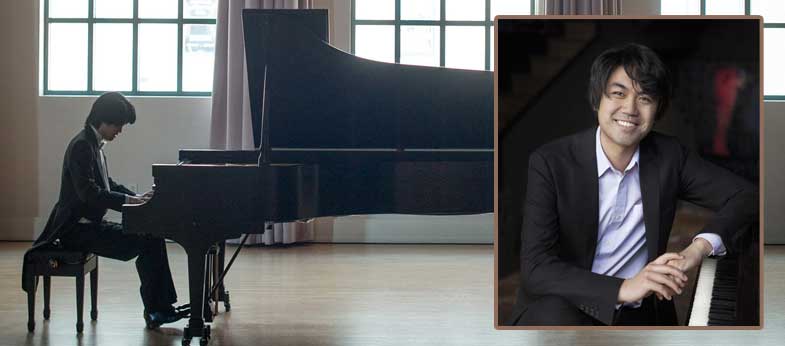
About
Hailed as a rising star with “an exceptional ability to connect with an audience combined with an easy virtuosity” (Huffington Post), 28-year-old American pianist Sean Chen, Bronze Medal winner at the 2013 Van Cliburn Competition and winner of the 2013 American Pianists Awards, continues to earn accolades for “alluring, colorfully shaded renditions” (New York Times). He has performed with many prominent orchestras, collaborating with such esteemed conductors as Leonard Slatkin and Nicholas McGegan. Solo recitals have brought him to major venues worldwide, including Boston’s Jordan Hall, the Smithsonian American Art Museum in Washington, D.C., the Taipei National Concert Hall, Amsterdam’s Concertgebouw, and Salle Cortot in Paris.
His CD releases include La Valse, a Steinway label solo recording, hailed for “penetrating artistic intellect” (Audiophile Audition), and a live Harmonia Mundi Cliburn Competition recording, praised for Sean’s “ravishing tone and cogently contoured lines” (Gramophone). Mr. Chen is a Steinway Artist and has contributed to Steinway and Sons’ new Spirio piano library. A multifaceted musician, he also transcribes, composes, and improvises. His encore improvisations are lauded as “genuinely brilliant” (Dallas Morning News).
A multifaceted musician, Mr. Chen also transcribes, composes, and improvises. His transcription of Ravel’s La Valse has been received with glowing acclaim, and his encore improvisations are lauded as “genuinely brilliant” (Dallas Morning News). His Prelude in F# was commissioned by fellow pianist Eric Zuber, and subsequently performed in New York.
When you hear him and meet him, we believe you will be as taken as our audience was when he appeared for us in 2013 and why Peninsula Reviews wrote, “Chen has it all: power, nuance, character and poetry…My guess is that [the San Joses] audience have already reserved future copies of anything he produces”
Program
Program Notes
Based on Chopin’s Prelude in A Major, Op. 28, No. 7, Frederico Mompou’s Variations on a Theme of Chopin evokes sentimental feeling. Mompou adds harmonies and more intimate voicing, often with touches of sadness and longing. The piece was originally intended for cello and piano with the cellist, Gaspar Cassadó, but was abandoned with only four variations completed and published in a set entitled Three Variations. Not until 1958, almost two decades later, when The Royal Ballet commissioned a ballet, did Mompou finish the remaining variations. Although the ballet was never produced, the music was published as the Variations on a Theme of Chopin and still captures the many moods and technical nuances of ballet.
Although Sonata-Ballade in F# Major was originally composed as a single movement, Nikolai Medtner expanded the movement, from 1912 to 1914, into a Ballade, Introduction and Finale. Medtner was a profoundly religious man, and students report that the sonata partly relates to a poem concerning Christ’s temptation in the desert, with a narrative balancing light with darkness. The piece opens with a lovely pastoral setting before dramatic crescendos to forte and diminuendos to piano follow one after another in a matter of measures. The finale contrasts a theme reminiscent of Schumann with a majestic version of the sonata’s opening theme before ending with the theme from the second movement.
Around 1900, Ravel joined a group of young musicians, artists and writers known as Les Apaches (“Hooligans”). He dedicated each of the five suites of Miroirs to a member of this group. Each suite represents the dedicatee. The first movement, Noctuelles, is highly chromatic and dark, while the second, Oiseaux tristes, depicts a sad bird, who has a fleeting moment of excitement before returning to a state of loneliness. Une barque sur l’ocean depicts a boat subject to the whims of ocean currents. Alborada del gracioso, the most technically challenging suite, intertwines complex Spanish themes. La vallée des cloches concludes the piece with harmonies evoking the sounds of different bells. Although the difficulty of Miroirs cannot compare with Ravel’s Gaspard de la nuit, the various personalities and styles give the performer plenty of virtuosic moments.
Ravel’s Le Tombeau de Couperin, written from 1914 to 1917, is a memorial for the composer’s friends who died fighting in World War I. The sixth and final movement, Toccata, is dedicated to Captain Joseph de Marliave, the husband of Marguerite Long, the pianist who premiered many of Ravel’s works, including, in 1919, Le Tombeau de Couperin. As a toccata, this short piece is light-fingered, fast and difficult. Ravel purposely intended the light-hearted feeling, believing that a somber, grim tone was not appropriate for the dead, who had already entered their “eternal silence.”